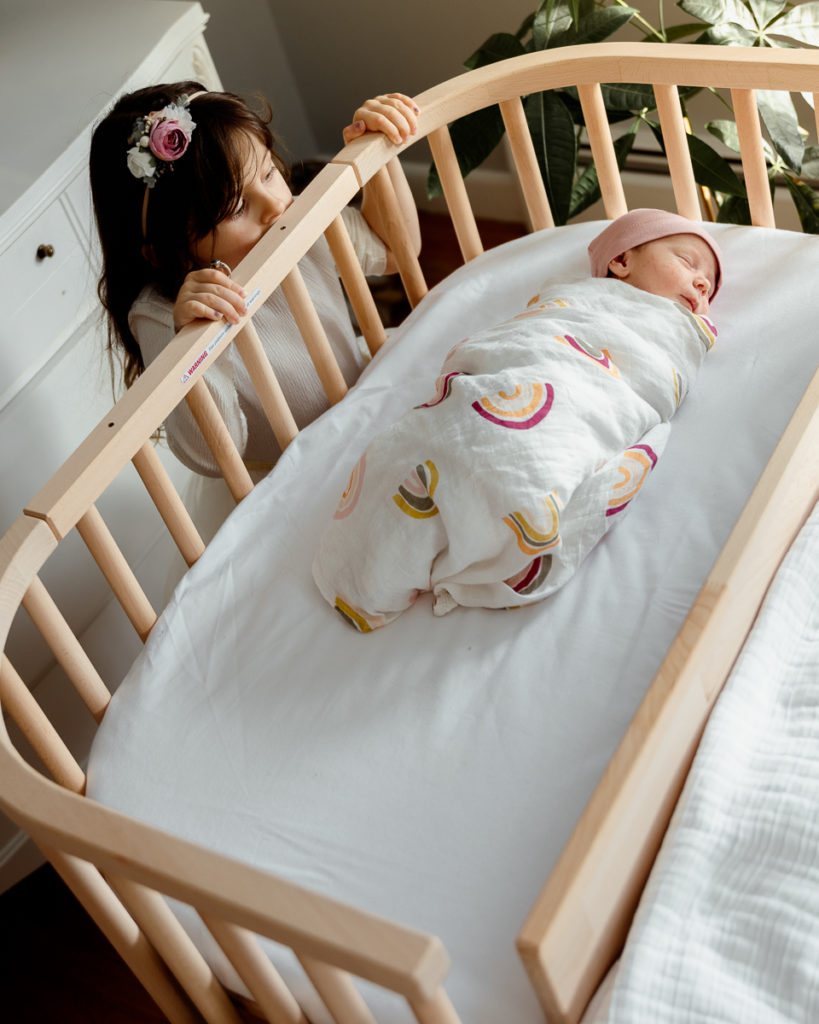Babies sleep a lot. By “a lot” we mean that you can expect your baby to sleep 16-18 hours a day throughout the first year of their life, waking in 2-3 hour intervals to feed, get changed, and be coddled back into peaceful slumber. (No wonder it’s so hard for parents who are sleeping with a newborn to wake up in the morning feeling rested and recharged!)
Adapting to your baby’s schedule is hard enough. But add confusion or concerns about the correct newborn sleep position into the mix and you’ve got a recipe for wakeful nights.
That’s why we’re about to break down everything you need to know about sleeping with a newborn, starting with the “where” of safe baby sleep and ending with the “how” of getting the best new-parent nights of rest possible.
Where Should Baby Sleep During the First Few Months?
According to the American Academy of Pediatrics (AAP), babies should sleep in the same room as their parents for at least the first six months of life, and ideally through the first year. This is a practice called room sharing, which refers to any sleep set-up where parents and baby sleep in the same room together, thought not on the same sleep surface. 
There’s a reason why room sharing is so well-loved by the AAP: not only is it a more convenient choice (making nighttime nursing and responding to any cry easy-as-can-be), but it also puts you in the best location to respond to your baby’s needs in the event of an emergency.
To prevent incidents of SIDS (Sudden Infant Death Syndrome,) timing is everything. The faster you can respond in the event of an emergency, the better.
By sleeping so close with your little one, you’ll also familiarize yourself with the sound of their breathing over time. This will make you well-prepared to recognize any blockages or other concerns that might need to be taken care of for them to sleep peacefully and safely.
I’ve Heard About Bed Sharing. Is That Safe?
It is completely natural to want to be as close to your baby as possible. It’s also completely natural to not love the feeling of reaching over crib bars multiple times per night (especially if you’re still healing from a c-section). And it’s totally natural to not want to risk waking up your hard-to-put-to-sleep baby by having to constantly take them out and put them back in their crib. 
While it may feel like the best option is to let your newborn sleep on your chest or tuck them into your own cozy comforter for a night of sleeping on your own mattress, the AAP clearly states that parents should never share a mattress with a newborn. This also includes putting your baby to sleep on a breastfeeding pillow or placing them in-between you and your partner.
To understand the “why” behind this recommendation, you need to understand that modern means of comfort are not ideally suited for infant safety. To maximize infant safety, your baby needs a flat and firm surface without extra cushioning that could accidentally cover their nose or make it hard for them to move.
(Reminder: your baby just came into this world, they’re still learning how to roll out of unsafe situations or untangle themselves when their breathing is obstructed.)
The sad reality is, accidents from bed sharing account for 50% of SIDS cases. Most of these cases come about from babies becoming tangled into sheets, rolling off the bed, or accidentally getting covered by pillows.
Luckily, there are now options on the market that allow you to get all the convenience of this close sleeping without having to worry about those risks.
Sleeping with a Newborn Without Risk: What to Know About Bedside Bassinets
When bedside bassinets and bedside co-sleepers first came on the market, they seemed like the answer to many parents’ prayers. Safe sleep tools like the babybay bedside sleeper keep newborns in close proximity to their parents all through the night (in fact, they get to sleep right by their parents’ side!), while still giving them a sleep space that’s perfectly designed to suit their safety needs. 
Parents who choose to sleep with a bedside sleeper can still experience the nighttime ease of nursing and comforting without getting out of bed, while knowing that their little one is sleeping on a mattress that meets all crib safety standards. In this way, your baby can be nurtured through close-as-can-be room sharing, without you having to worry about any of the risks that come from bed sharing.
The Best Newborn Sleep Position: Sleeping on the Back
Back sleeping will always be the safest option for your newborn baby. This position keeps your baby’s airflow clear and open, which prevents chocking and leads to easy nights of catching Zs for both you and them. Unlike sleeping on one’s side or stomach, laying on the back allows for your baby’s natural gag reflexes to take over, which will prevent any obstruction of airflow from occurring.
Though it’s not totally uncommon to see a baby sleeping on side, this isn’t the newborn sleep position most recommended by the AAP. That’s for one very simple reason: when you have a baby sleeping on side, it’s too easy for them to roll on to their stomach.
Experts have long warned against stomach sleeping, in part because it can lead to overheating or lowered oxygen levels. It will take a few months (normally 4-6) for your little one to learn how to roll to their stomach on their own. When this time comes, you should still continue to put your child to sleep on their back. If they naturally happen to roll onto their stomach during the night, don’t fret.
As long as you continue to put them to sleep back-down, you don’t have to worry about this kind of mid-night rolling.
How to Guarantee a Safe Sleep Surface
Though getting your baby a safe and made-just-for-them baby bed is a good start, you can help your baby stay safe and secure all night long by sticking with a few best practices for sleep accessories.
We completely understand the desire to make your baby’s crib as cozy as possible, but, the AAP recommends keeping cribs clutter-free. For the first year, your crib should only contain a firm mattress and a fitted sheet. Extra pillows, blankets, and toys can all quickly become dangerous if your baby rolls or if something gets pushed over their airways in the middle of the night.
So keep it simple and remember: when it comes to sleeping with a newborn, less is more.







